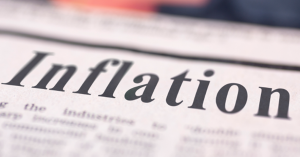Inflation: Transitory or Here to Stay?

High inflation is the topic de jure as prices continue to rise in the post-pandemic economic recovery. Policy makers, bankers, consumers and business people are all asking whether the current inflationary environment is “transitory” or if inflation is here to stay.
In the latest US Bureau of Labor Statistics report, the US Consumer Price Index rose by 6.2% year over year for the month of October, 2021, the highest level in more than three decades. In this report, gasoline prices were up 50% year over year, and used car prices were up 26% in the same period. Core inflation, which strips out volatile food and energy prices to gain a more accurate picture of the inflationary environment, shows prices rising at 4.6% year over year, which is more than double the trend for the last 25 years.
Economists’ views are mixed in their forecasts regarding the short and long term trajectory of inflation, along with the underlying economic trends causing the upward pressure on prices. Current inflation appears to be primarily driven by pandemic-related causes such as supply chain bottlenecks and disruptions, and a growing economy due to economic stimulus. The debate is whether these pressures will continue, keeping inflation high, or fade over time, returning us to the economic environment we have been accustomed to for the last several decades.
The US Federal Reserve has described the current inflationary environment as “transitory” and has taken a more cautious approach to deploying its tools to fight inflation. The Fed’s argument is that current elevated prices are due to global supply chain disruptions, and as the world returns to normal, these pricing pressures will decrease. During the pandemic, aggregate demand from businesses and consumers drastically shifted towards goods and away from services. Per the Fed, as this demand reallocates across economic sectors and supply chain bottlenecks resolve themselves, the upward pressure on prices should diminish. As a result of this belief, the Fed is taking a cautious approach to inflation, with no plans to raise rates in the near future (which is their primary tool to fight rising prices).
Moreover, many economists argue that the deflationary pressures that plagued the Western world and Japan before the pandemic still exist and will likely persist. Specifically, before the pandemic, these economies struggled with downward pressure on prices caused by high debt levels, an aging work force, increasingly skewed income and wealth distributions, and globalization. These economists argue that all of these downward pressures on prices remain and are unlikely to change.
However, some economists believe that the Fed is not doing enough to fight inflation. These inflation hawks primarily cite the unprecedented economic stimulus in response to COVID-19, from both the Federal government and the Federal Reserve, as having created a surge of cash in the financial system. In response to this argument, inflation doves have cited the sharp narrowing of the fiscal deficit combined with the Fed’s recently announced taper of its stimulative asset purchases . The Fed will reduce such asset purchases beginning in November, 2021 and completely end the program by July, 2022. With the expiration of COVID related benefits, the Federal deficit will shrink from 13% of GDP in 2021 to 5% in 2022, sharply reducing economic spending by the government.
Economists have also expressed concern that the deflationary pressures of globalization had already begun to wane prior to the pandemic as a result of the Trump administration’s sharp change in China trade policy, with the pandemic only reinforcing the need to have more local supply chains. These trends may keep pressure on the supply of goods and the benefits of globalization may be less acute going forward as American workers are no longer competing as fiercely with their low-wage Chinese counterparts for manufacturing jobs.
In addition, high energy prices are likely here to stay as the result of a trifecta of depressed supply, decarbonation initiatives, and a rapidly reopening world continue to upend world energy markets. During the pandemic, the world’s major energy companies slashed their capital budgets which significantly limited their investments in new fossil fuel supplies over the coming years. In addition, these companies are under tremendous pressure from both their shareholders and politicians to decarbonize, further reducing their incentive to invest in new oil and gas wells. This has created an environment where new supplies of oil and gas will be limited in the coming years, creating upward price pressure on what is still the world’s dominant form of energy.
There are countless variables, trends, and data points that support either view regarding pricing pressures going forward. One thing economics can agree on is that the inflation outlook is far from clear, and only time will tell if the current inflationary environment will be a temporary phenomenon, or if inflation will be here for the long term.
By Wesley King
Associate at Frandzel Robins Bloom & Csato, L.C.
